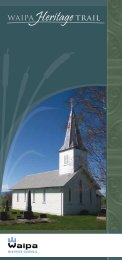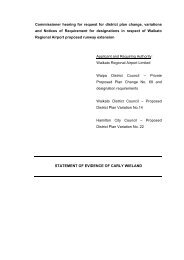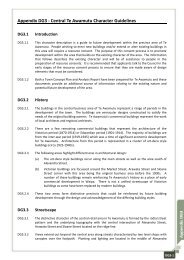Regulatory Committee Agenda - Waipa District Council
Regulatory Committee Agenda - Waipa District Council
Regulatory Committee Agenda - Waipa District Council
You also want an ePaper? Increase the reach of your titles
YUMPU automatically turns print PDFs into web optimized ePapers that Google loves.
148<br />
defines the Waikato River as: "-The Waikato River and its catchments, including all<br />
water courses, tributaries and streams, flowing into the River''.<br />
15.5 The Settlement Act will work in conjunction with the RMA and a number of other<br />
statutes, to provide direction for planning documents created under the RMA to<br />
protect the health and wellbeing of the Waikato River for future generations. The<br />
Settlement Act addresses a number of issues related to the Waikato River such as,<br />
redress for certain assets, the regulation of customary activities, and the<br />
management of the Waikato River. Although more planning documents will be<br />
created in relation to the regulation of the Waikato River, the vision and strategy will<br />
provide the overarching direction. The Settlement Act provides for a single cogovernance<br />
entity to set the agenda for the health and wellbeing of the Waikato<br />
River for future generations.<br />
15.6 The site is not located near any water bodies and any future wastewater or<br />
stormwater systems will be required to be designed by a suitability qualified engineer<br />
and approved by <strong>Council</strong>. This will ensure that these systems are suitable for the<br />
location and do not give rise to effects on any water bodies therefore giving effect to<br />
the directions and outcomes in the Waikato River Vision and Strategy.<br />
16. PART 2- PURPOSE AND PRINCIPALS OF THE RESOURCE<br />
MANAGEMENT ACT<br />
16.1 Section 104 of the RMA is subject to Part 2, the purpose and principles of the RMA.<br />
This part of the report examines the purposes and principles as set out in sections 5,<br />
6, 7 and 8. All of the section 104 analysis conducted in the previous parts of this<br />
report is subject to the relevant matters in these sections.<br />
16.2 Section S requires an overall broad judgement of whether or not a proposal<br />
promotes the sustainable management of natural and physical resources. In making<br />
such a judgement, it is necessary to compare conflicting considerations and the scale<br />
or degree of those conflicting considerations and their relative significance to the<br />
final outcome.<br />
16.3 Sections 6, 7 and 8 are the other sections in Part 2 of the RMA, and their function is<br />
to inform and assist the purpose ofthe RMA in sectionS. These subsequent sections<br />
should be approached as factors in the overall balancing exercise to be conducted in<br />
reaching a broad conclusion under Part 2.<br />
Section 8<br />
16.4 The RMA requires that those making decisions under the RMA must take into<br />
account the principles of the Treaty of Waitangi. The requirements to take into<br />
account the principles of the Treaty of Waitangi means that those with statutory<br />
functions under the Act should be informed of, and actively consider, the concerns<br />
and needs oftangata whenua.<br />
16.5 Section 8 has been characterised as the clause which recognises the relationship of<br />
tangata whenua with natural and physical resources and encourages active<br />
Report to <strong>Regulatory</strong> Ct111mlttee MeeUna- (19 Novwmber 2012)<br />
Thomton Ridge Trust<br />
Page16






